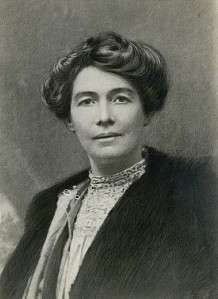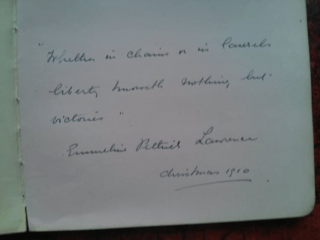Emmeline Pethick-Lawrence, Baroness Pethick-Lawrence
| Emmeline Pethick-Lawrence | |
|---|---|
| Lady | |
 | |
| Born |
21 October 1867 Clifton, Bristol, England |
| Died |
11 March 1954 (aged 86) Gomshall, Surrey, England |
Emmeline Pethick-Lawrence, Lady Pethick-Lawrence (21 October 1867 – 11 March 1954)[1] was a British women's rights activist.
Biography
Emmeline Pethick was born on 21 October 1867 in Bristol. Her father was a businessman. She was the second of 13 children, and was sent away to boarding school at the age of eight.
From 1891 until 1895 she worked as a "sister of the people" for the West London Mission at Cleveland Hall, near Fitzroy Square. She helped Mary Neal to run the girls club at the mission. In the autumn of 1895 she and Mary Neal left the mission to co-found the Espérance Club, a girls club that would not be subject to the constraints of the mission, and could experiment with dance and drama.[2]
Pethick also started Maison Espérance, a dressmaking cooperative with a minimum wage, an eight-hour day and a holiday scheme. She married Frederick Lawrence in 1901 and the pair took the joint name Pethick-Lawrence. She was a member of the Suffrage Society and was introduced to Emmeline Pankhurst in 1906. She became treasurer of the Women's Social and Political Union (WSPU) and raised £134,000 over six years.[3]

Pethick-Lawrence started the publication Votes for Women with her husband in 1907. The couple was arrested and imprisoned in 1912 for conspiracy following demonstrations that involved breaking windows, even though they had disagreed with that form of action. After being released from prison, the Pethick-Lawrences were unceremoniously ousted from the WSPU by Emmeline Pankhurst and her daughter Christabel because of their ongoing disagreement over the more radical forms of activism which the Pethick-Lawrences opposed. They then joined the United Suffragists. Emmeline was present at the Women's Peace Congress in 1915 at the Hague. She stood as Labour candidate for Manchester Rusholme in 1918.[3]
In the year 1938 Pethick-Lawrence published her comprehensive memoirs that especially deal with the radicalization of the Suffrage Movement in the eve of the First World War.[4]
In 1945 she became Lady Pethick-Lawrence when her husband was made a baron.[5]
Foundations, organisations and settlements
- Espérance Club
- Guild of the Poor Brave Things
- Independent Labour Party
- Kibbo Kift
- West London Methodist Mission
- Women's International League
- Women's Social and Political Union (WSPU)
See also
- Frederick Lawrence (spouse). Each changed their surname to Pethick Lawrence on marriage, and later to Pethick-Lawrence, and he was created Baron Pethick-Lawrence in 1945.
- History of feminism
- Hugh Price Hughes
- Lady Constance Lytton on whom she was a significant influence to become an activist.
- List of suffragists and suffragettes
- List of women's rights activists
- Mark Guy Pearse, whom Lady Pethick-Lawrence described as "the greatest influence upon the first half of my life".[6]
- Suffragette
- Timeline of women's rights (other than suffrage)
- Timeline of women's suffrage
- Women's Social and Political Union
- Women's suffrage
- Women's suffrage in the United Kingdom
- Women's suffrage organisations
References
- ↑ "Emmeline Pethick-Lawrence © Orlando Project". cambridge.org.
- ↑ Judge, Roy (1989). "Mary Neal and the Espérance Morris" (PDF). Folk Music Journal. 5 (5): 548. Retrieved 28 August 2013.
- 1 2 Uglow, Jennifer S. (1985). "Pethick-Lawrence, Emmeline". The International Dictionary of Women's Biography. New York: Continuum. pp. 370–371. ISBN 0-8264-0192-9.
- ↑ Emmeline Pethick-Lawrence (1938): My Part in a Changing World. London 1938.
- ↑ Rappaport, Helen (2001). "Pethick-Lawrence, Emmeline". Encyclopedia of women social reformers. 1. [A – L]. Santa Barbara, Calif. [u.a.]: ABC-CLIO. p. 548. ISBN 978-1-57607-101-4.
- ↑ Brian Harrison, 'Lawrence, Emmeline Pethick-, Lady Pethick-Lawrence (1867–1954)', Oxford Dictionary of National Biography, Oxford University Press, Sept 2004; online edn, May 2006 accessed 17 Nov 2007
External links
| Wikimedia Commons has media related to Emmeline Pethick-Lawrence. |